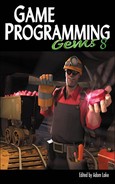- Copyright
- Preface
- Acknowledgments
- Contributors
- 1. Graphics
- Introduction
- 1.1. Fast Font Rendering with Instancing
- 1.2. Principles and Practice of Screen Space Ambient Occlusion
- 1.3. Multi-Resolution Deferred Shading
- 1.4. View Frustum Culling of Catmull-Clark Patches in DirectX 11
- 1.5. Ambient Occlusion Using DirectX Compute Shader
- 1.6. Eye-View Pixel Anti-Aliasing for Irregular Shadow Mapping
- 1.7. Overlapped Execution on Programmable Graphics Hardware
- 1.8. Techniques for Effective Vertex and Fragment Shading on the SPUs
- 2. Physics and Animation
- Introduction
- 2.1. A Versatile and Interactive Anatomical Human Face Model
- 2.2. Curved Paths for Seamless Character Animation
- 2.3. Non-Iterative, Closed-Form, Inverse Kinematic Chain Solver (NCF IK)
- 2.4. Particle Swarm Optimization for Game Programming
- A Few Words on Optimization
- The PSO Paradigm and Its Canonical Formulation
- Add-Ons to the Classical Formulation
- A Note on Randomness
- Case Study 1: Typical Benchmarking Functions
- Case Study 2: Optimization of Physical Parameters for In-Game Vehicle Simulation
- Case Study 3: Physics-Based Animation of Mechanical Systems
- Conclusion
- References
- 2.5. Improved Numerical Integration with Analytical Techniques
- Classifying Errors
- Kinematics of Constant Acceleration
- The Kinematic Integrator
- Integral Contributions Due to a Spring Force
- Multiple Forces
- Integral Contributions of a Pulse
- Integral Contributions of Collision Forces
- Integral Contributions of Viscous Forces
- Integral Contributions of Constraint Forces
- Summary
- Conclusion
- 2.6. What a Drag: Modeling Realistic Three-Dimensional Air and Fluid Resistance
- 2.7. Application of Quasi-Fluid Dynamics for Arbitrary Closed Meshes
- 2.8. Approximate Convex Decomposition for Real-Time Collision Detection
- 3. AI
- Introduction
- 3.1. AI Level of Detail for Really Large Worlds
- 3.2. A Pattern-Based Approach to Modular AI for Games
- 3.3. Automated Navigation Mesh Generation Using Advanced Growth-Based Techniques
- 3.4. A Practical Spatial Architecture for Animal and Agent Navigation
- 3.5. Applying Control Theory to Game AI and Physics
- 3.6. Adaptive Tactic Selection in First-Person Shooter (FPS) Games
- 3.7. Embracing Chaos Theory: Generating Apparent Unpredictability through Deterministic Systems
- 3.8. Needs-Based AI
- 3.9. A Framework for Emotional Digital Actors
- 3.10. Scalable Dialog Authoring
- 3.11. Graph-Based Data Mining for Player Trace Analysis in MMORPGs
- 4. General Programming
- Introduction
- 4.1. Fast-IsA
- 4.2. Registered Variables
- 4.3. Efficient and Scalable Multi-Core Programming
- 4.4. Game Optimization through the Lens of Memory and Data Access
- 4.5. Stack Allocation
- 4.6. Design and Implementation of an In-Game Memory Profiler
- 4.7. A More Informative Error Log Generator
- 4.8. Code Coverage for QA
- 4.9. Domain-Specific Languages in Game Engines
- 4.10. A Flexible User Interface Layout System for Divergent Environments
- 4.11. Road Creation for Projectable Terrain Meshes
- 4.12. Developing for Digital Drawing Tablets
- 4.13. Creating a Multi-Threaded Actor-Based Architecture Using Intel® Threading Building Blocks
- 5. Networking and Multiplayer
- Introduction
- 5.1. Secure Channel Communication
- 5.2. Social Networks in Games: Playing with Your Facebook Friends
- 5.3. Asynchronous I/O for Scalable Game Servers
- 5.4. Introduction to 3D Streaming Technology in Massively Multiplayer Online Games
- 6. Audio
- 7. General Purpose Computing on GPUs
- Introduction
- 7.1. Using Heterogeneous Parallel Architectures with OpenCL
- 7.2. PhysX GPU Rigid Bodies in Batman: Arkham Asylum
- Requirements
- Shape Representation
- Dynamics Algorithm
- Pipeline
- Transform Spheres into World Space
- Sphere-Sphere Collision Detection
- Sphere-Mesh Collision Detection
- Evaluate Force Fields
- Calculate Unconstrained Velocities
- Generate Constraints
- Solver
- Update Positions
- GPU Implementation
- CUDA Voxelizer
- Spatial Data Structures
- Solver
- Conclusion
- Acknowledgements
- References
- 7.3. Fast GPU Fluid Simulation in PhysX
- Color Plate
In this edition of the Game Programming Gems series, we explore a wide range of important real-time graphics topics, from lynchpin systems such as font rendering to cutting-edge hardware architectures, such as Larrabee, PlayStation 3, and the DirectX 11 compute shader. Developers in the trenches at top industry studios such as Blizzard, id, Bizarre Creations, Nexon, and Intel’s Advanced Visual Computing group share their insights on optimally exploiting graphics hardware to create high-quality visuals for games.
To kick off this section, Aurelio Reis of id Software compares several methods for accelerating font rendering by exploiting GPU instancing, settling on a constant-buffer-based method that achieves the best performance.
We then move on to two chapters discussing the popular image-space techniques of Screen Space Ambient Occlusion (SSAO) and deferred shading. Dominic Filion of Blizzard Entertainment discusses the SSAO algorithms used in StarCraft II, including novel controls that allowed Blizzard’s artists to tune the look of the effect to suit their vision. Hyunwoo Ki of Nexon then describes a multi-resolution acceleration method for deferred shading that computes low-frequency lighting information at a lower spatial frequency and uses a novel method for handling high-frequency edge cases.
For the remainder of the section, we concentrate on techniques that take advantage of the very latest graphics hardware, from DirectX 11’s tessellator and compute shader to Larrabee and the PlayStation 3. Rahul Sathe of Intel presents a method for culling of Bezier patches in the context of the new DirectX 11 pipeline. Jason Zink then describes the new DirectX 11 compute shader architecture, using Screen Space Ambient Occlusion as a case study to illustrate the novel aspects of this new hardware architecture. In a pair of articles from Intel, Nico Galoppo and Allen Hux describe a method for integrating anti-aliasing into the irregular shadow mapping algorithm as well as a software task system that allows highly programmable systems such as Larrabee to achieve maximum throughput on this type of technique. We conclude the section with Steven Tovey’s look at the SPU units on the PlayStation 3 and techniques for achieving maximum performance in the vehicle damage and light pre-pass rendering systems in the racing game Blur from Bizarre Creations.
-
No Comment
